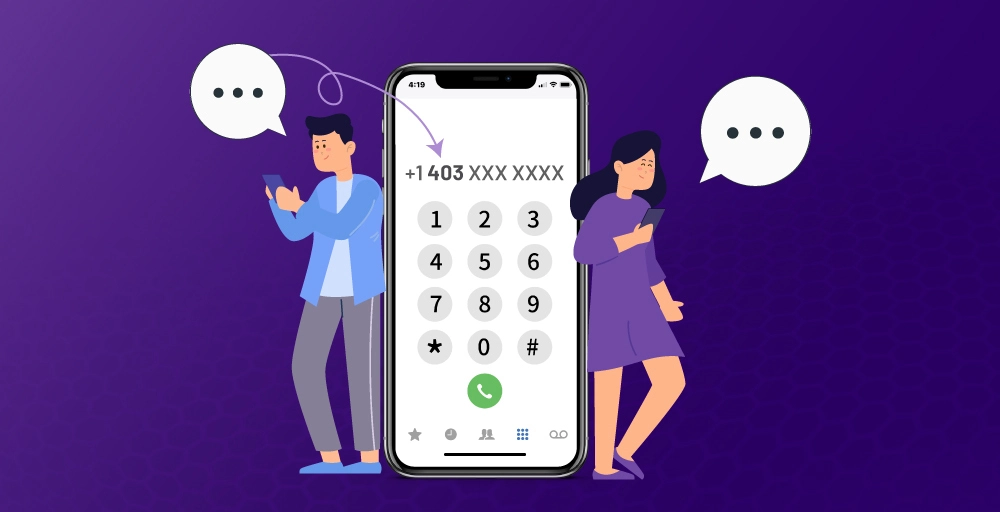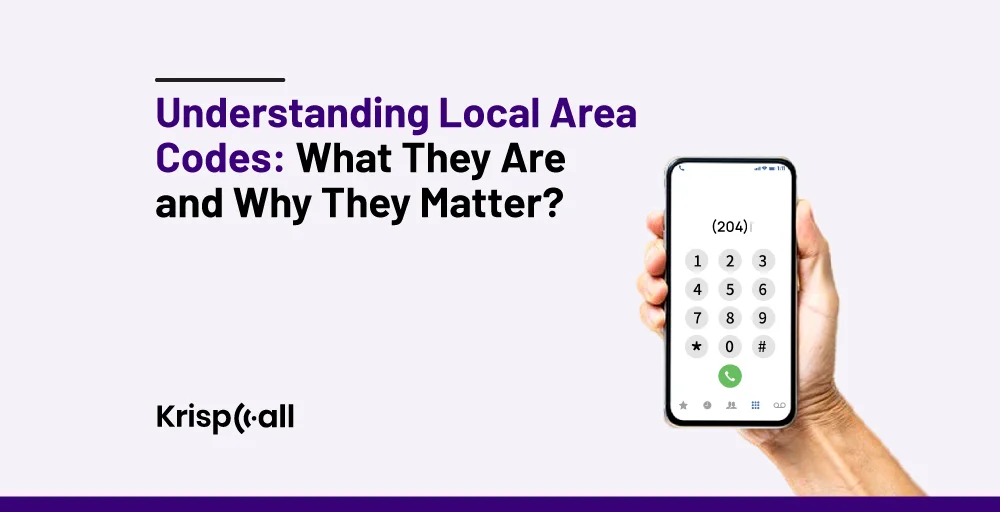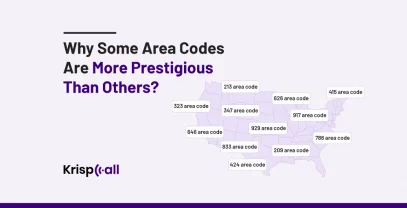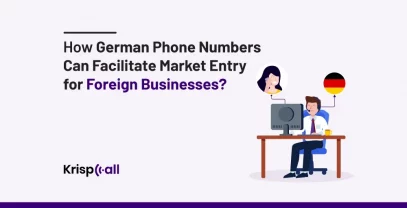Have you ever paused and wondered about the first few numbers you entered before the actual phone numbers? What are they, and what are their role?🤷
Well, these numbers are local area codes, and they are the foundational components to efficiently uniting people, understanding regional identities, and allowing seamless communication📱.
Regardless of your interest—whether you’re a businessman planning to expand, a traveler, or a student—understanding the meaning behind certain local area codes can help you open doors 🚪you never even knew were there.
📝In this blog, we will examine every local area code in more detail and explain why understating local area codes is much more important than you think. We will also discuss the format and structure of the area code.
🔐KEY HIGHLIGHTS:
- Local area codes are three-digit numbers, including special prefixes that indicate certain geographical zones in a country to ensure proper call routing.
- The area code has its own specific structure which consists of country code, area code & local phone number.
- The different types of area codes are geographical, nongeographical, special service, and overlaid local area codes.
- By understanding local area codes is crucial to every business and individual as it adds multiple benefits like increasing credibility and trust, improving customer engagement, enhancing marketing & advertisement, lowering calling costs, convenience & familiarity along with a sense of security.
What Is The Local Area Code?
The local area code is a digit or sequence of digits at the beginning of the telephone number allocated to a particular geographical area within the country. These codes are always 3-digit, and their main purpose is to reroute and connect phone calls between distinct regions.

The ability to define an area code was first introduced in the mid-20th century with the North American Numbering Plan (NANP) declaration in 1947. As the area codes were introduced, visualizing the telephone network became automated and proved far more efficient and trustworthy.
Similarly, competition has continued to thrive due to technological advancements in modern society, and local area codes are still important in telecommunications. Local area codes are vital for call routing, help control network congestion overload, and enhance service quality.
What Are The Structure And Format Of Area Codes?
Understanding local area codes’s structure and format is crucial for connecting within different regions. Likewise, multiple area codes have a structured format that enhances call efficiency and routes phone calls accurately.
You can connect globally with the correct structure and format of the area code. Here are the structure and format of the area code phone number, along with the dialing procedure:
Structure
- Country Code: The country code is the numerical code before the phone number to denote the country it belongs to. It is normally up to 3 digits and sometimes only 1. For instance, the country code for the United Kingdom (UK) is “44,” and Canada’s is “1.”
- Area Code: The area code is a three-digit number corresponding to a certain geographical zone within a state. It helps direct traffic to the proper region, such as “212” for Manhattan, New York City.
- Local Phone Number: The local phone number is the number that comes immediately after the area code and would always be seven digits in some cases. It refers to a specific telephone line number within the defined area code.
Format
- (Area Code) Local Phone Number: This format puts the area code in parenthesis after putting a space between it and the local phone number. For example, (212) 555-1234.
- Area Code—Local Phone Number: This format uses a hyphen in the middle to divide the area code and the local telephone number. For example, 212-555-1234.
- Country Code – Area Code – Local Phone Number: This format presents the country calling code, the area code of the geographical area that has been assigned, and the local telephone number—for instance, 1-212-555-1234(US number).
Example Of US Area Codes
Following are the examples illustrating how area codes are used with local numbers to form a complete US phone number; the examples of US area codes along with popular cities are:
| Popular Cities | Area Codes |
| New York City, NY | 212, 315, 347, 516, 518, 585, 607, 631, 646, 716, 718, 845, 914, 917, 929 |
| Los Angeles, CA | 213, 310, 424, 661, 818, 323 |
| Chicago, IL | 312, 773 |
| Houston, TX | 713, 281, 832, 346 |
| Philadelphia, PA | 215, 267, 445 |
| Phoenix, AZ | 480, 602, 623 |
| San Diego, CA | 615, 858 |
| Miami, FL | 305, 786, 645 |
| Atlanta, GA | 404, 470, 678, 770 |
| Dallas, TX | 214, 469, 972 |
Example Of Canada Area Code
Here are the examples of Canada area codes along with their popular cities:
| Popular Cities | Area Codes |
| Toronto, ON | 416, 647, 905 |
| Vancouver, BC | 236, 250, 604, 778 |
| Montreal, QC | 514, 438, 263 |
| Calgary, AB | 403, 587 |
| Ottawa, ON | 613, 343, 753 |
| Edmonton, AB | 780, 587 |
| Quebec City, QC | 418, 581, 367 |
| Winnipeg, MB | 204, 431, 584 |
| Halifax, NS | 902, 782 |
| Victoria, BC | 250, 236, 778 |
What Are The Different Types Of Area Codes?
The different types of area codes are given below:
1. Geographical Area Codes
Geographical area codes are defined over certain geographical areas within a country. Usually, they are three-digit codes that determine a geographical area connected with a telephone number. For instance, in the US, when the digits of an area code is 212, it is associated with Manhattan, New York City.
Similarly, these area codes are responsible for connecting calls between different regions and avoiding confusion in identifying the intended party. They are normally issued depending on the region’s density, the number of telephone lines, and the frequency of calls made.
2. Non-Geographical Area Codes
Non-geographical area codes are not associated with any geographical area but have other uses, like mobile numbers, free numbers, and broad services. These area codes provide flexibility to the users who move from one location to another while keeping the same phone number.
Moreover, non-geographical area codes meet specific communication needs without relying on any particular place. For example, in the United States, the area code 800 is used for toll-free numbers, where callers can call without making any payments, regardless of location.
3. Special Service Codes
The special service code refers to codes assigned to specific services that do not align with the geographical or non-geographical codes. For example, in the United States, dialing 911 connects the caller directly to emergency services.
Likewise, special service codes help people access essential services and information quickly. They also make it easier for people to locate necessary numbers than to remember the entire string of numbers on the phone, saving time and energy.
4. Overlaid Local Area Codes
Overlaid local area codes are used when existing ones run out of numbers due to rising population and higher phone service usage. The main importance of overlaid code is that it doesn’t split the region or its central offices into multiple area codes; rather, it adds a new one that coexists with the existing one.
However, callers should dial full 10-digit phone numbers and area codes to complete calls within the overlaid areas. They also help control resources and enhance coverage more effectively without disturbing the phone numbers and services.
What Are The Benefits Of Local Area Codes?
By proper understanding and implementation of local area codes, its usage can be beneficial for both businesses and individuals. Some of which are discussed here:
For Business:
- Increased credibility and trust: Local area codes increase a business’s credibility within specific areas. Similarly, customers trust a local number more, which can assist in building good business relationships with their customers.
- Improved Customer Engagement: The local area codes allow customers to reach the business forums without necessarily incurring long-distance call rates. This aspect effectively enhances customer engagement and makes them happier while shopping, thus improving sales.
- Enhanced Marketing and advertisement: A phone number with a relevant local area code may make the business more attractive to local consumers. It informs that the business is a part of the community, increasing the impact of marketing and advertisements.
For Individual:
- Lower Calling Costs: Local area codes mean less or no charges for calls within a similar area, helping individuals save their money. This mainly benefits those individuals who are often on-call within their locality or region of the country.
- Convenience and Familiarity: People and companies interact smoothly because a local area code is familiar to them. It makes dialing easier and clarifies whether the call is to be received as a local call, a long-distance call, or a call from a different zone.
- Sense of security: Having a local area code helps individuals achieve security. They will be reassured about being in a local community and have a familiar feeling of safety. This will help them securely connect with local services, families, and friends.
Conclusion
Thus, local area codes remain a synchronizing factor relevant to shaping communication contexts globally in modern times. They link geographic locations, dissolve the possibility of regional constraints on businesses, and boost individual interaction.
Furthermore, Understanding local area codes is an important element that requires identification. Today, area and office codes continue to serve a significant purpose to businesses and individuals since they can enhance a company’s reliability, marketing efficiency, cheaper tariffs, convenience, and security.
FAQ
How Are Area Codes Assigned?
Area codes are assigned based on geographic regions, population density, phone number demand, and regulatory authorities.
Can Local Area Codes Change?
Yes, local area codes can change over time due to population growth, technological advancements, or regulatory decisions.
Are Local Area Codes Important For International Calls?
No, local area codes are not important for International calls as they primarily connect domestic geographic regions within a country.
What Is Area Code Overlay?
An area code overlay is a method used to manage phone number shortages within a specific geographic region.





